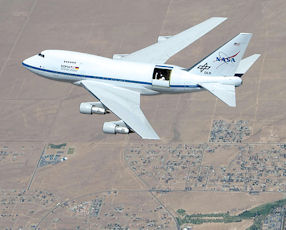The SOFIA observatory is something special by any measure. It weighs 17 tons, can peer deep into the universe and is carried aboard a modified 747 jumbo jet. It also may get grounded before barely starting its scientific mission. The stratospheric observatory for infrared astronomy – its name is an acronym – is based at the NASA Armstrong Flight Research Center in Palmdale, but is in danger of being mothballed on Sept. 30 due to federal budget cuts. SOFIA received $84 million in funding for the current fiscal year but only $12 million has been set aside for the 2015 fiscal year as NASA gave funding priority to other programs. Supporters worry that if the program that collects data and photos of planets, comets, stars and other stellar objects is mothballed, it will not only lead to layoffs but be hard to restart. “Once you lose the personnel the momentum on the program is lost,” said Palmdale Mayor Jim Ledford. A joint project of NASA and the German Aerospace Agency, which supplied the optical telescope, SOFIA has been housed in Palmdale in a hangar leased from Los Angeles World Airports since early 2008. The telescope aboard SOFIA studies stellar objects on the infrared spectrum, which requires it to fly 40,000 feet or higher to be above the water vapor that disrupts infrared light. That sounds pricey but program costs are below the orbiting Hubble Space Telescope, which must be repaired in outer space. There are 120 people at NASA Armstrong on the program – 47 civil servants and 73 contractors. There also are 20 employees in Palmdale assigned from Ames Research Center in Mountain View who fly aboard the plane and take care of the scientific instruments. Ledford went to Washington, D.C. in late March to lobby for continued funding, and said he returned feeling positive the plane will keep flying its missions. “(Cancellation) will take a budget allocation and permission from Congress and we are hearing that is not likely to happen,” he added. Still, NASA Armstrong is taking steps to seek alternative funding sources. On April 11 it invited potential partners to the Palmdale facility to gauge interest in securing the aircraft for science or other missions at a cost of $1 million per flight. Mothballing the SOFIA aircraft would come just as the observatory could make some real scientific progress. It took several years to calibrate and certify the instruments used on the telescope, said Brent Cobleigh, deputy program manager. Four instruments have been certified and work started on a fifth in April, he added. SOFIA has a mission to collect data for 960 hours in flights that last up to 10 hours each. “To get there we have to fly four flights a week,” he said. – Mark R. Madler
